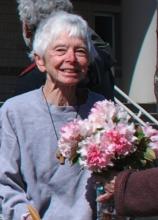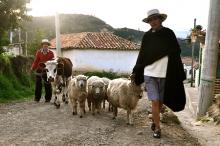Christian Peacemaker Teams

Anne Montgomery died this week. I remember her words to me and to our young Iraqi friend Eva, sitting in the Al Monzer hotel in Amman, Jordan. This was in 2006, and she’d waited three weeks for a visa to enter Iraq as a peace witness. Anne had crossed into zones of conflict more times than any other activist I’d known. During these weeks with us, she’d been meeting and working with Iraqi refugees, many of them undocumented and struggling to eke out a living in Jordan.
Now the wait was over. The visas were not forthcoming, and Anne had decided she was needed most in the Palestinian West Bank city of Hebron, where the Christian Peacemaker Team — at that point, she had been a “CPT-er” for 11 years — was particularly short staffed and had requested a month of her time. She was going to attempt the crossing from Jordan into Israel by taxi, since Israel could very well have refused her entry, and we were to save a bed for her. But for the moment, we treasured the chance to learn from her in case this was a parting.
It was, and a greater parting has now come, so I take comfort in her words, and rededicate myself to taking direction from them.
The news spread through the city of Suleimaniya so quickly. Within an hour, Kurdish news outlets let the locals know that something bad had happened. From there, it moved even more quickly across the ocean.
By the evening of March 1, I was shocked to read it in my Manitoba prairie city’s newspaper: “Iraqi student kills American teacher in Christian school murder-suicide.“
Along with the bare facts, the questions and rumours arose. Why had the 18-year-old Kurdish boy carried a handgun to class in a Christian school in Suleimaniya and shot his teacher to death?
Was it the result of religious disagreement?
Was there some other kind of conflict between the two of them?
How could a handgun have entered the classroom?
Some our Kurdish partners called a meeting to see if some sort of action should take place. None of us had known either the teacher or the boy. Reports said that this type of shooting was not so unusual, that it happens in the United States all the time. But violence like this had never happened in a school in Kurdish Northern Iraq. Kurds were reeling and asking themselves what is it about their country that allows people to settle differences with a gun in a classroom?

Colombia's campesinos ("people of the land") — peasants, farmers and artisanal miners, the indigenous — are calling out for an end to the exploitation and environmental destruction of their lifelong territories and homes.
They call out for a restoration of their livelihoods. Greed and violence punishing their land is also visited upon the campesinos themselves, leaving them dead, disappeared or disenfranchised as one of the world's largest internally displaced people groups.
The campesinos of Colombia have come together and called out.
Will we listen?
Will we locate our own story in theirs?
Will justice be done? Are we willing to work for it?
For nearly six years, the Palestinian residents of the West Bank village of Bil'in have held a weekly nonviolent demonstration against the separation wall -- a barrier cutting through large portions of
"Let's listen in now to the Marine Corps Band," the CNN commentator says. The camera pans across the Washington Mall. People, as far as the eye can see, waiting for the historic moment, the inauguration of the 44th President of the United States of America, the first African American to ever hold this high office.
Three Christian Peacemaker Teams members who were held captive for 118 days in Iraq met in Britain last December—after police asked them to testify in the trial of their alleged captors&mdash
Just a note to thank you for your Christian Peacemaker Teams feature in the December 2006 issue (“118 Days,” by James Loney, Harmeet Singh Sooden, Peggy Gish, and Rose Marie Berger).
More than 100 Palestinians from the village of At-Tuwani, including these children, attended a vigil in December for four members of the Christian Peacemaker Teams.
Christian Peacemaker Teams members Kim Lamberty and Chris Brown were attacked Sept. 29 by five Israeli settlers while accompanying Palestinian school children south of Hebron.
George Weber, 73, of Chesley, Ontario, was killed in a motor accident on January 6 while traveling with a Christian Peacemaker Team delegation north of Basrah, Iraq.
A young Israeli soldier kicks a small rubber ball to two Palestinian boys in the West Bank city of Hebron, his machine gun slapping gently against his back as he moves. His fellow soldiers smoke and play cards nearby. Men in long flowing robes and white headscarves pass boys riding donkeys, tiny Palestinian shops loaded with film and souvenirs, and stores whose doorways are filled with bulging sacks of colored spices and grains.
Just beyond the soldiers sits an immense, foreboding building—one of its two entrances is guarded by Palestinian soldiers, the other by Israelis. It’s called the Mosque of Abraham or the Tomb of the Patriarchs, depending on who’s speaking, and inside are massive stones marking the supposed burial sites of Abraham and Sarah. Concrete walls enclose the tombstones. Muslims and Jews can view them through a set of iron bars, but only from separated parts of the building. The structure was bisected in 1994 after a Jewish settler, an American, entered the building and killed 49 Palestinians preparing to celebrate the Muslim holy month of Ramadan.
The Israeli soldiers are also in Hebron, a Palestinian-controlled city of about 140,000, to guard Jewish settlers who live down the street in a compound distinctive for its brand-new buildings and the barbed wire that surrounds it. "Five hundred soldiers are here to guard 30 settler families," according to Bourke Kennedy, a member of the Christian Peacemaker Team in Hebron. The Jewish settlement is one of four in the Hebron district; roughly 6,000 Jewish settlers live in two settlements on the city’s outskirts. Because of their political and symbolic importance, settlements such as these have been targets—and impetus—for Hamas and other Palestinian groups who have resisted the Israeli occupation with violence.